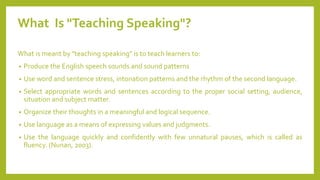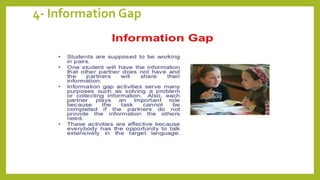TechniquesinTeachingSpeakingSkill.pptx
- 1. TECHNIQUES INTEACHING SPEAKING SKILL By Dr. Hanan Alsalihi Practicum, 2020
- 2. Introduction Speaking is "the process of building and sharing meaning through the use of verbal and non-verbal symbols, in a variety of contexts" (Chaney, 1998, p. 13). Speaking is a crucial part of second language learning and teaching. Despite its importance, for many years, teaching speaking has been undervalued and English language teachers have continued to teach speaking just as a repetition of drills or memorization of dialogues. However, today's world requires that the goal of teaching speaking should improve students' communicative skills, because, only in that way, students can express themselves and learn how to follow the social and cultural rules appropriate in each communicative circumstance. In order to teach second language learners how to speak in the best way possible, some speaking activities are provided below, that can be applied to intermediate level students.
- 3. What Is "Teaching Speaking"? What is meant by "teaching speaking" is to teach learners to: • Produce the English speech sounds and sound patterns • Use word and sentence stress, intonation patterns and the rhythm of the second language. • Select appropriate words and sentences according to the proper social setting, audience, situation and subject matter. • Organize their thoughts in a meaningful and logical sequence. • Use language as a means of expressing values and judgments. • Use the language quickly and confidently with few unnatural pauses, which is called as fluency. (Nunan, 2003).
- 4. HowToTeach Speaking Now many linguistics and ESL teachers agree on that students learn to speak in the second language by "interacting". Communicative language teaching and collaborative learning serve best for this aim. Communicative language teaching is based on real-life situations that require communication. By using this method in ESL classes, students will have the opportunity of communicating with each other in the target language. In brief, ESL teachers should create a classroom environment where students have real-life communication, authentic activities, and meaningful tasks that promote oral language. This can occur when students collaborate in groups to achieve a goal or to complete a task.
- 5. ActivitiesTo Promote Speaking 1- Discussions After a content-based lesson, a discussion can be held for various reasons. The students may aim to arrive at a conclusion, share ideas about an event, or find solutions in their discussion groups. Before the discussion, it is essential that the purpose of the discussion activity is set by the teacher. In this way, the discussion points are relevant to this purpose, so that students do not spend their time chatting with each other about irrelevant things. For example, students can become involved in agree/disagree discussions. In this type of discussions, the teacher can form groups of students, preferably 4 or 5 in each group, and provide controversial sentences like “people learn best when they read vs. people learn best when they travel”.
- 6. Discussion Then each group works on their topic for a given time period, and presents their opinions to the class. It is essential that the speaking should be equally divided among group members. At the end, the class decides on the winning group who defended the idea in the best way. This activity fosters critical thinking and quick decision making, and students learn how to express and justify themselves in polite ways while disagreeing with the others. For efficient group discussions, it is always better not to form large groups, because quiet students may avoid contributing in large groups. The group members can be either assigned by the teacher or the students may determine it by themselves, but groups should be rearranged in every discussion activity so that students can work with various people and learn to be open to different ideas. Lastly, in class or group discussions, whatever the aim is, the students should always be encouraged to ask questions, paraphrase ideas, express support, check for clarification, and so on.
- 7. 2- Role Play One other way of getting students to speak is role-playing. Students pretend they are in various social contexts and have a variety of social roles. In role-play activities, the teacher gives information to the learners such as who they are and what they think or feel. Thus, the teacher can tell the student that "You are David, you go to the doctor and tell him what happened last night, and…" (Harmer, 1984)
- 10. 5- Brainstorming
- 11. 6- Storytelling Students can briefly summarize a tale or story they heard from somebody beforehand, or they may create their own stories to tell their classmates. Story telling fosters creative thinking. It also helps students express ideas in the format of beginning, development, and ending, including the characters and setting a story has to have. Students also can tell riddles or jokes. For instance, at the very beginning of each class session, the teacher may call a few students to tell short riddles or jokes as an opening. In this way, not only will the teacher address students’ speaking ability, but also get the attention of the class.
- 12. 7- Interviews Students can conduct interviews on selected topics with various people. It is a good idea that the teacher provides a rubric to students so that they know what type of questions they can ask or what path to follow, but students should prepare their own interview questions. Conducting interviews with people gives students a chance to practice their speaking ability not only in class but also outside and helps them becoming socialized. After interviews, each student can present his or her study to the class. Moreover, students can interview each other and "introduce" his or her partner to the class.
- 13. 8- Story Completion • This is a very enjoyable, whole-class, free-speaking activity for which students sit in a circle. • Each student is supposed to add from four to ten sentences. Students can add new characters, events, descriptions and so on.
- 14. 9- Reporting Before coming to class, students are asked to read a newspaper or magazine and, in class, they report to their friends what they find as the most interesting news. Students can also talk about whether they have experienced anything worth telling their friends in their daily lives before class.
- 15. 10- Playing Cards In this game, students should form groups of four. Each group will represent a topic. For instance: • Diamonds: Earning money • Hearts: Love and relationships • Spades: An unforgettable memory • Clubs: Best teacher Each student in a group will choose a card. Then, each student will write 4-5 questions about that topic to ask the other people in the group. For example: If the topic "Diamonds: Earning Money" is selected, here are some possible questions: • Is money important in your life? Why? • What is the easiest way of earning money? • What do you think about lottery? Etc. However, the teacher should state at the very beginning of the activity that students are not allowed to prepare yes-no questions, because by saying yes or no students get little practice in spoken language production. Rather, students ask open-ended questions to each other so that they reply in complete sentences.
- 17. 12- Picture Describing This activity fosters the creativity and imagination of the learners as well as their public speaking skills.
- 18. 13- Find the Difference For this activity students can work in pairs and each couple is given two different pictures, for example, picture of boys playing football and another picture of girls playing tennis. Students in pairs discuss the similarities and/or differences in the pictures. ThankYou
- 19. Assignment: (Individual application) next week, you are required to send video for your lesson plan. I’ll assign each student a lesson number, and she’ll present a full lesson as she’s in real classroom. While she’s presenting, someone from the family is recording video for her. Please behave as you are in the classroom and present the lesson. Each week we will watch all together (me and you) 5 students presenting in videos and I’ll open the discussion for you. I’ll announce the names with their lessons for the coming week’s lecture to get ready and present. This is what we supposed to do before the curfew (15 scores). Your lessons will be from 2nd intermediate textbook. I wont accept any delays in submitting your videos + lesson plans. The following names will present next Sunday 26th, April, 2020. Unit and lesson section name no Unit and lesson section name no Unit 1 lesson 1 C Marwa Jassim Mohammed 1- Unit 1 lesson 1 B Fatima Mohsen 1- Unit 1 lesson 2 C Qabas Hussein 2- Unit 1 lesson 2 B Rawaa Hussein 2- Unit 1 lesson 3 C Nour Awda 3- Unit 1 lesson 3 B Zahraa Falah 3- Unit 1 lesson 4 C Manar Dhia 4- Unit 1 lesson 4 B Mariam Adil 4- Unit 1 lesson 6 C Mariam Mowayad 5- Unit 1 lesson 6 B ShaimaaThamir 5-


















